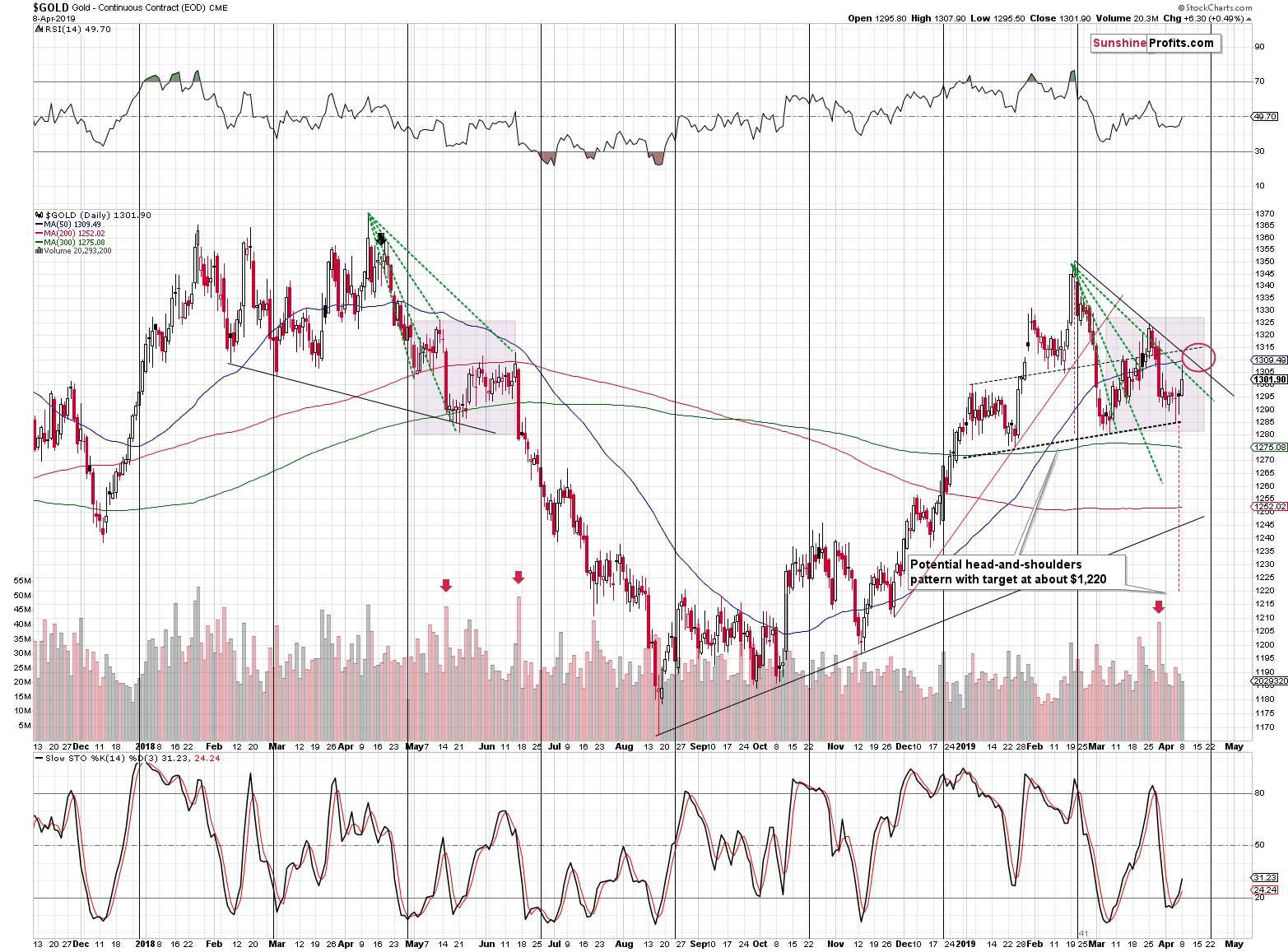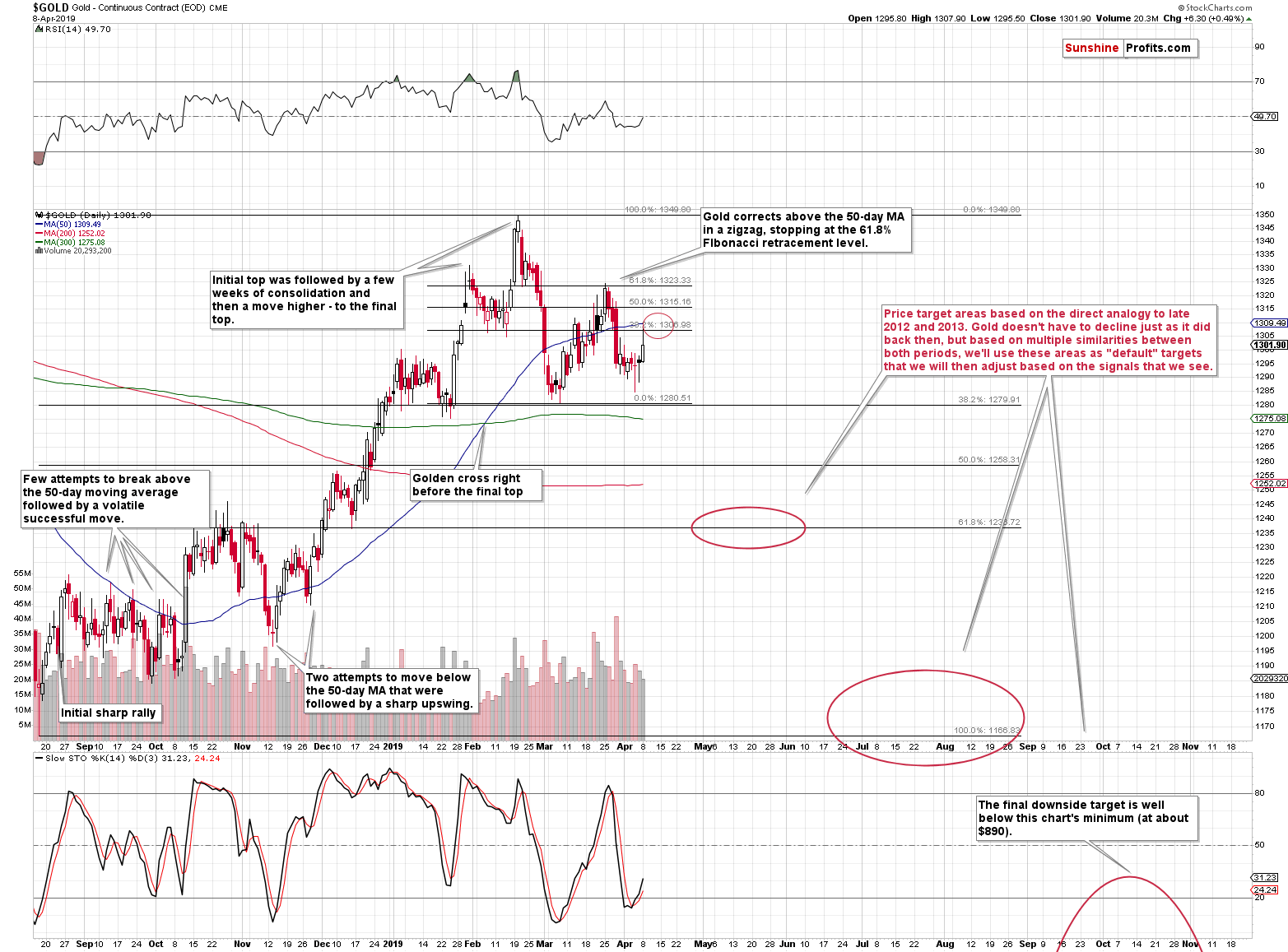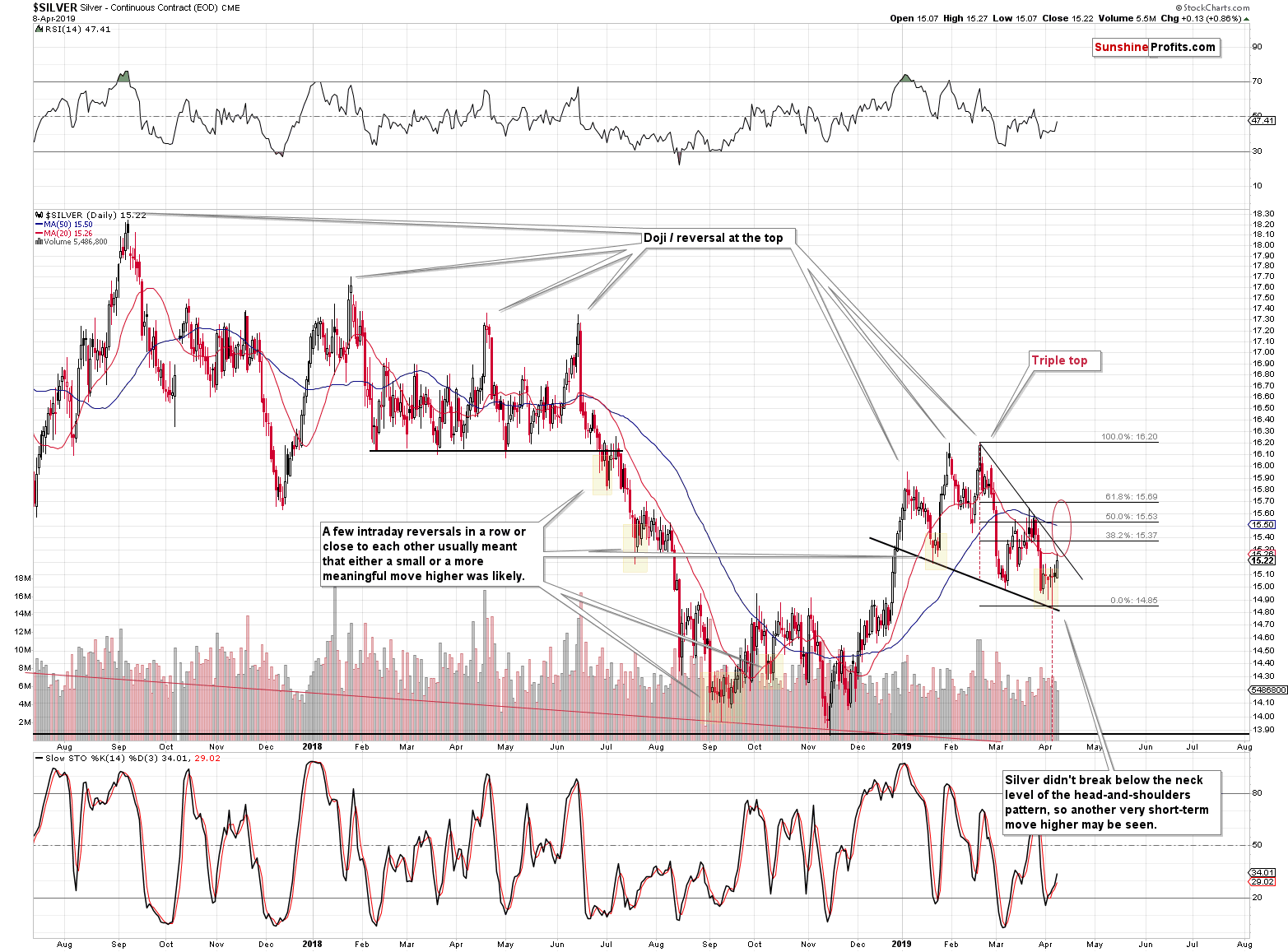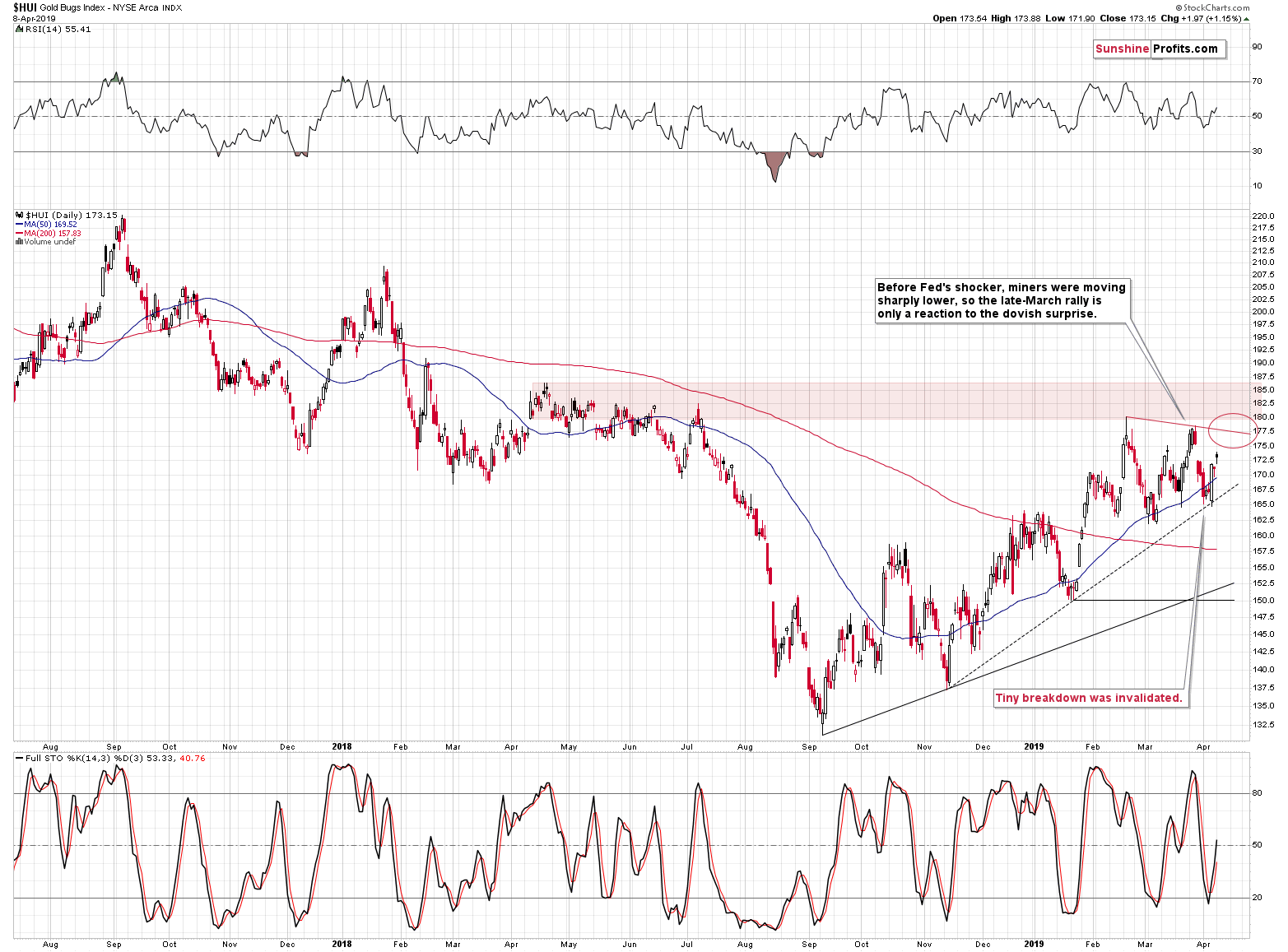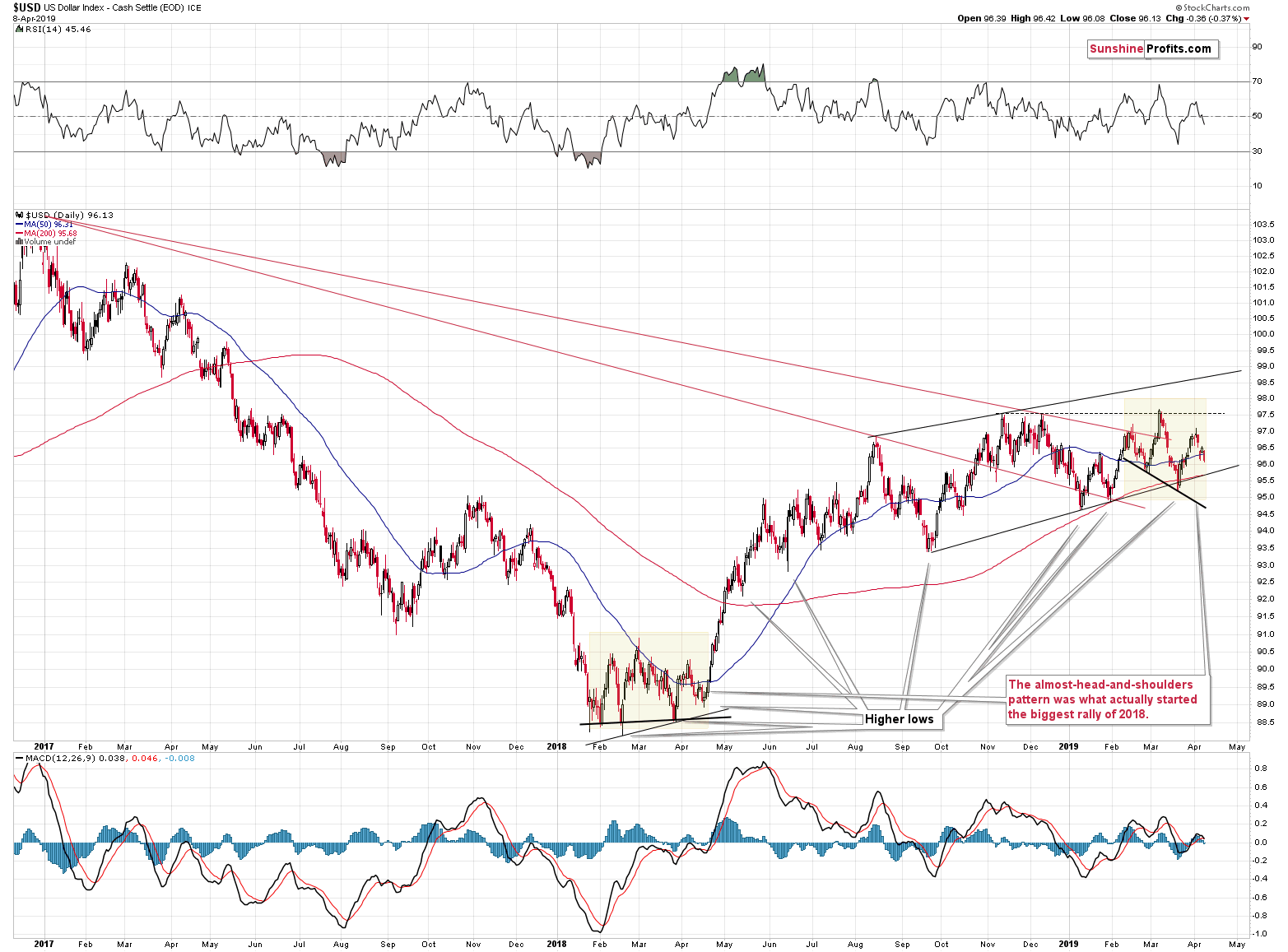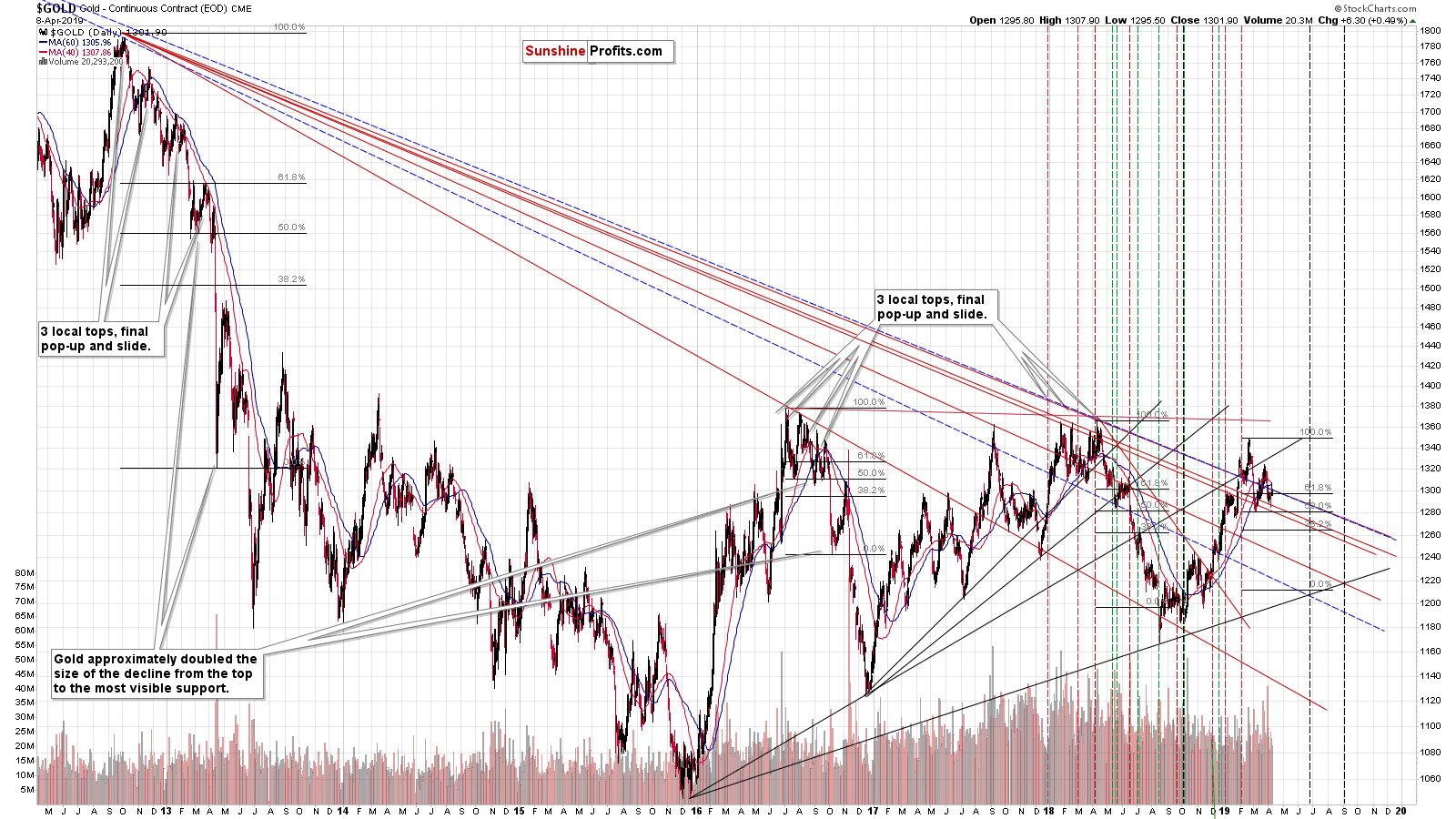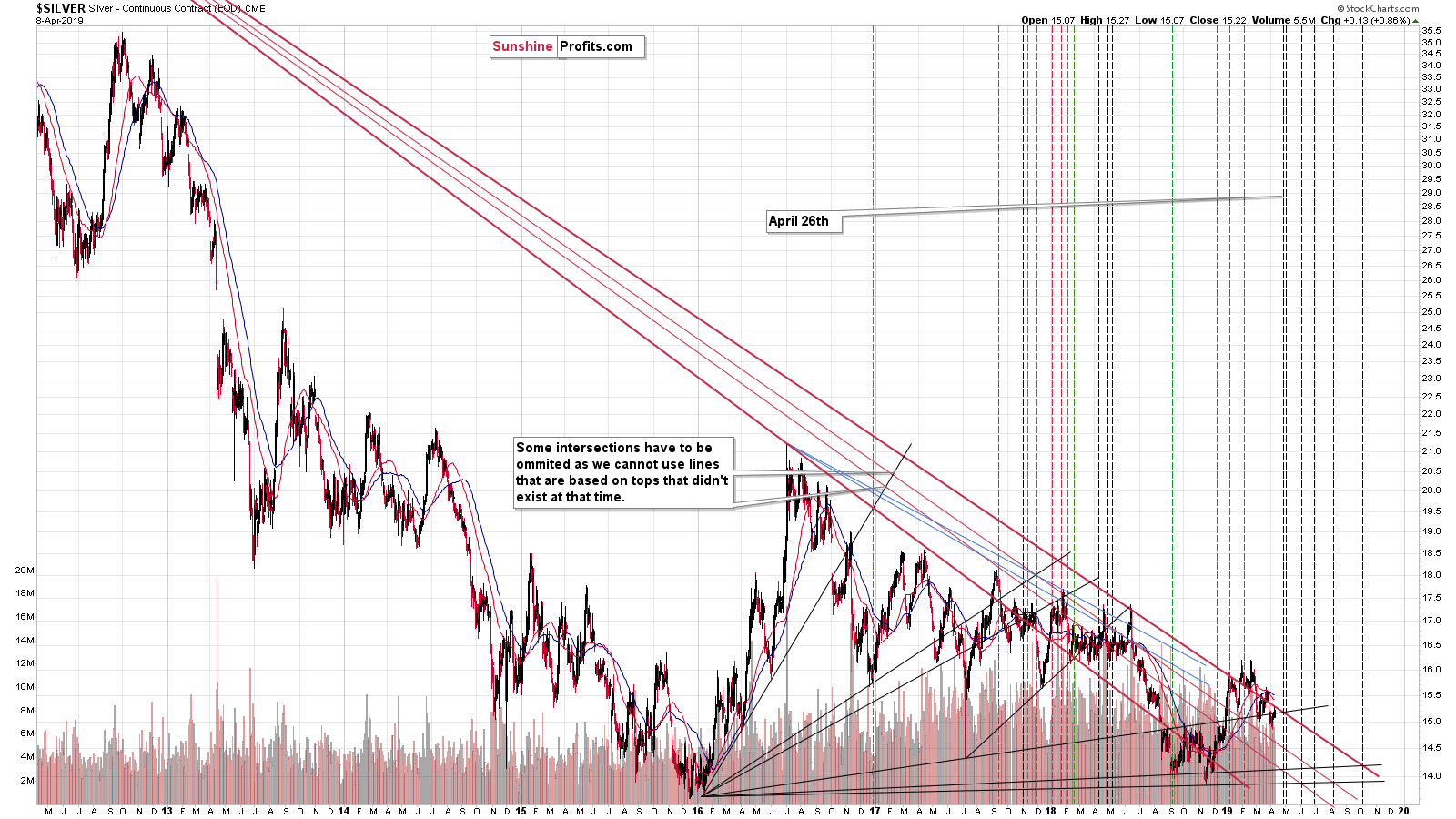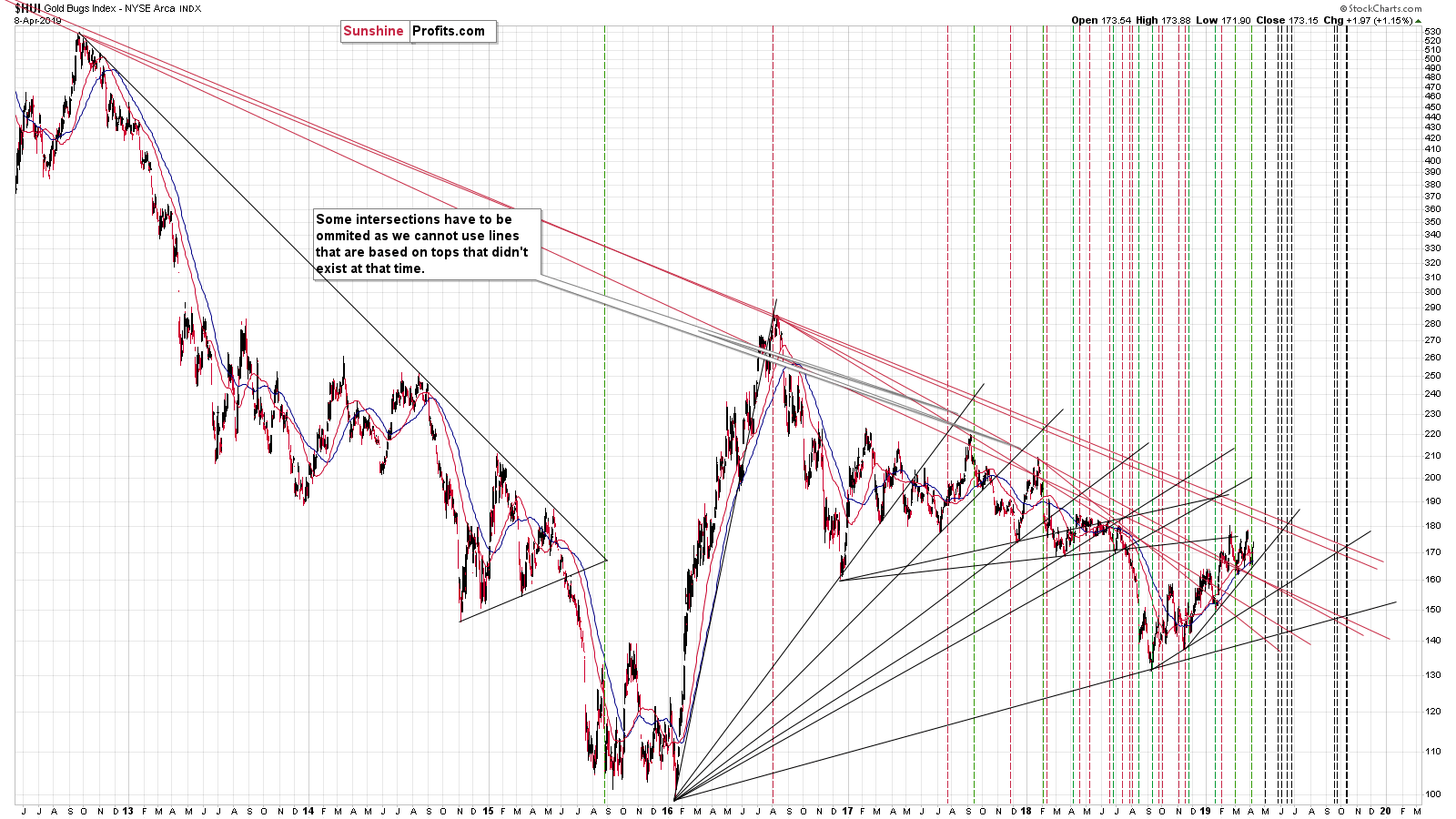Briefly: in our opinion, full (100% of the regular size of the position) speculative short position in gold, silver, and mining stocks is justified from the risk/reward perspective at the moment of publishing this Alert. In other words, we are increasing the size of the speculative short position.
As we had expected, gold rallied, and it almost reached its 50-day moving average. Silver rallied as well, but it only reached its 20-day MA; its 50-day MA is visibly higher. Meanwhile, mining stocks appear to be gathering strength before attempting to break to new highs. Will they succeed? The short-term outlook has greatly improved based on the recent bullish reversal, but did it improve enough for miners to break to new yearly highs in short order?
Not likely, and if so, the breakout will likely be small and shortly invalidated. Let’s take a look at the details, starting with gold.
Gold Topping Out
Gold moved to our target area, which means that the odds for the top being in have increased. This is precisely why we decided to increase the size of our short position. The other reason is that the shape of yesterday’s upswing is similar to the way in which gold topped in early December 2012.
The early December upswing ended with a reversal during which gold almost reached the 50-day moving average.
That’s exactly what happened yesterday. Does it have to be the final top? No. The counter-trend upswing in 2012 took more than a week, not just 2 days. There was an initial top that was then followed by a pause and the final reversal. Something like that seems also quite possible this time. The above is also confirmed by the silver action.
Silver’s Hint
Silver rallied yesterday, but it was nothing to call home about. The white metal moved just a bit higher and – what’s most important here – silver didn’t outperform gold during this upswing. Silver usually rallies the most during the final part of a given upswing and this is often a useful bearish confirmation – the final call to exit any remaining long positions and enter short ones.
Since silver only reached the lower part of our target area and it didn’t outperform gold yet, the situation became more bearish for the short term, but not extremely so.
Can Gold Stocks’ Rally Go On?
Gold stocks didn’t reach any specific resistance level, so their rally is likely to continue. Since gold miners usually move along with gold and silver, the above suggests that the top may not yet be in for this short-term upswing.
The short-term fate of the precious metals sector may depend on one of its key drivers – the USD Index.
What Does the USD Index Say?
The US currency moved a bit below its 50-day moving average, but it didn’t reach any strong support level just yet. The nearest support is at about 95.7 and the next one is at about 95.4. The former is provided by the rising medium-term support line and the latter is the March low. The former is more likely to stop the decline. That would result in the next bottom being higher than the previous one – this has been the tendency for months now.
The above chart is a reason for the precious metals sector to move a bit higher in the short run, but not significantly so. At the moment of writing these words, the USDX is already 0.10 lower, so the potential size for additional downswing is very limited.
Before summarizing, we would like to update you on the upcoming and – in one case – recent triangle-vertex-based reversals for the precious metal market.
On the Lookout for PMs Reversals
In case of gold and silver, there are no meaningful vertex-based reversals in the next several days. The closest one is at the end of April. If PMs slide, they will be likely to correct close to April 26th.
In case of the miners, however, there is one additional reversal that is worth keeping in mind.
It’s the one that we saw right now. Why is something that already happened an important thing? Because it shows that the rally that is taking place is just a technical correction – something that is in tune with what had been quite possible based on the past patterns – not a substantial show of strength that defies them. Consequently, it’s not a game-changer – it’s part of the original game. And just like the preceding trends and signals have been pointing to much lower mining stock values in the following months, they continue to do so also today.
Let’s move back to gold’s vertex chart once again. For your convenience, we will copy it below.
This time, please focus on two specific rules that we saw in case of three previous declines.
The first rule is that there are three tops before the decline really starts. There’s also a smaller correction and that’s pretty much it – then gold just drops.
The early-2013, September 2016, and May 2018 upswings were all the above-mentioned “smaller corrections” after which gold took a dive.
In 2019, the late-January top, the late-February top, and the late-March top were the three tops as per the above-mentioned rule. What we’re seeing now is likely the final “smaller correction” after which gold is likely to take a dive.
The second rule is that an important intermediate bottom takes place at the price that we get by doubling the size of the initial volatile drop. On the above chart, we applied this rule by using the Fibonacci retracements in a non-standard way. The starting point is the top (for instance the 2012 top) and the second point that we use is the initial bottom (February 2013 bottom) to which we apply the 50% Fibonacci retracement. The end of the Fibonacci tool shows where gold would need to be in order to double the initial the decline.
This technique worked in all three major declines that we see above: the initial 2013 slide, the late-2016 decline, and the 2018 decline. The important thing is that this technique doesn’t necessarily point to the final bottom – just an intermediate one.
In case of the current situation, this technique points to about $1,215 as the next downside target. Based on other techniques, we have been expecting gold to form an intermediate bottom at about $1,220 or $1,240. The technique described today doesn’t have to be 100% precise, so it seems to confirm the lower of the targets. It might also be the case that about $1,220 is the intraday low, while $1,240 is the bottom in terms of the closing prices. Either way, it seems that there’s quite a decline ahead in gold, before even the interim bottom is reached.
Summary
Summing up, it’s almost certain that the next big move lower has already begun and that the 2013-like slide is in its early stage. The early stage is not as volatile as the final stage and periodic corrections may take place, such as the one we see right now. Based on the shape of gold’s reversal, the corrective rally might be over, but there are also other signs that point to continuation thereof. Even if gold, silver, and miners move higher from here, they are not likely to rally far before reversing and resuming their big declines.
Based on the increased likelihood that the top is in, we are increasing the size of our short position. As planned, we are doing so at higher prices than the ones at which we had closed four fifths of the position. Also, if you entered a long position based on our analysis of short-term factors, it might be a good idea to take your profits off the table. At the moment of writing these words, spot gold is at about $1,301, gold futures are at about $1,306 and the easy part of the rally is over.
As always, we will keep you – our subscribes – informed.
To summarize:
Trading capital (supplementary part of the portfolio; our opinion): Full short position (100% of the full position) in gold, silver, and mining stocks is justified from the risk/reward perspective with the following stop-loss orders and exit profit-take price levels:
- Gold: profit-take exit price: $1,062; stop-loss: $1,357; initial target price for the DGLD ETN: $82.96; stop-loss for the DGLD ETN $39.87
- Silver: profit-take exit price: $12.32; stop-loss: $16.44; initial target price for the DSLV ETN: $47.67; stop-loss for the DSLV ETN $23.68
- Mining stocks (price levels for the GDX ETF): profit-take exit price: $13.12; stop-loss: $24.17; initial target price for the DUST ETF: $76.87; stop-loss for the DUST ETF $15.47
Note: the above is a specific preparation for a possible sudden price drop, it does not reflect the most likely outcome. You will find a more detailed explanation in our August 1st Alert. In case one wants to bet on junior mining stocks’ prices (we do not suggest doing so – we think senior mining stocks are more predictable in the case of short-term trades – if one wants to do it anyway, we provide the details), here are the stop-loss details and target prices:
- GDXJ ETF: profit-take exit price: $17.52; stop-loss: $35.67
- JDST ETF: initial target price: $143.87 stop-loss: $30.97
Long-term capital (core part of the portfolio; our opinion): No positions (in other words: cash)
Insurance capital (core part of the portfolio; our opinion): Full position
Whether you already subscribed or not, we encourage you to find out how to make the most of our alerts and read our replies to the most common alert-and-gold-trading-related-questions.
Please note that the in the trading section we describe the situation for the day that the alert is posted. In other words, it we are writing about a speculative position, it means that it is up-to-date on the day it was posted. We are also featuring the initial target prices, so that you can decide whether keeping a position on a given day is something that is in tune with your approach (some moves are too small for medium-term traders and some might appear too big for day-traders).
Plus, you might want to read why our stop-loss orders are usually relatively far from the current price.
Please note that a full position doesn’t mean using all of the capital for a given trade. You will find details on our thoughts on gold portfolio structuring in the Key Insights section on our website.
As a reminder – “initial target price” means exactly that – an “initial” one, it’s not a price level at which we suggest closing positions. If this becomes the case (like it did in the previous trade) we will refer to these levels as levels of exit orders (exactly as we’ve done previously). Stop-loss levels, however, are naturally not “initial”, but something that, in our opinion, might be entered as an order.
Since it is impossible to synchronize target prices and stop-loss levels for all the ETFs and ETNs with the main markets that we provide these levels for (gold, silver and mining stocks – the GDX ETF), the stop-loss levels and target prices for other ETNs and ETF (among other: UGLD, DGLD, USLV, DSLV, NUGT, DUST, JNUG, JDST) are provided as supplementary, and not as “final”. This means that if a stop-loss or a target level is reached for any of the “additional instruments” (DGLD for instance), but not for the “main instrument” (gold in this case), we will view positions in both gold and DGLD as still open and the stop-loss for DGLD would have to be moved lower. On the other hand, if gold moves to a stop-loss level but DGLD doesn’t, then we will view both positions (in gold and DGLD) as closed. In other words, since it’s not possible to be 100% certain that each related instrument moves to a given level when the underlying instrument does, we can’t provide levels that would be binding. The levels that we do provide are our best estimate of the levels that will correspond to the levels in the underlying assets, but it will be the underlying assets that one will need to focus on regarding the signs pointing to closing a given position or keeping it open. We might adjust the levels in the “additional instruments” without adjusting the levels in the “main instruments”, which will simply mean that we have improved our estimation of these levels, not that we changed our outlook on the markets. We are already working on a tool that would update these levels on a daily basis for the most popular ETFs, ETNs and individual mining stocks.
Our preferred ways to invest in and to trade gold along with the reasoning can be found in the how to buy gold section. Additionally, our preferred ETFs and ETNs can be found in our Gold & Silver ETF Ranking.
As a reminder, Gold & Silver Trading Alerts are posted before or on each trading day (we usually post them before the opening bell, but we don't promise doing that each day). If there's anything urgent, we will send you an additional small alert before posting the main one.
=====
Latest Free Trading Alerts:
US labor market strengthened again and the yield curve inversion looks to be over. Has the sky cleared? Hold on, Brexit is just around the corner. Given the circumstances, are gold prices more likely to rise or fall?
Will Recovery in Payrolls and Yield Curve Sink Gold?
=====
Thank you.
Sincerely,
Przemyslaw Radomski, CFA
Editor-in-chief, Gold & Silver Fund Manager


